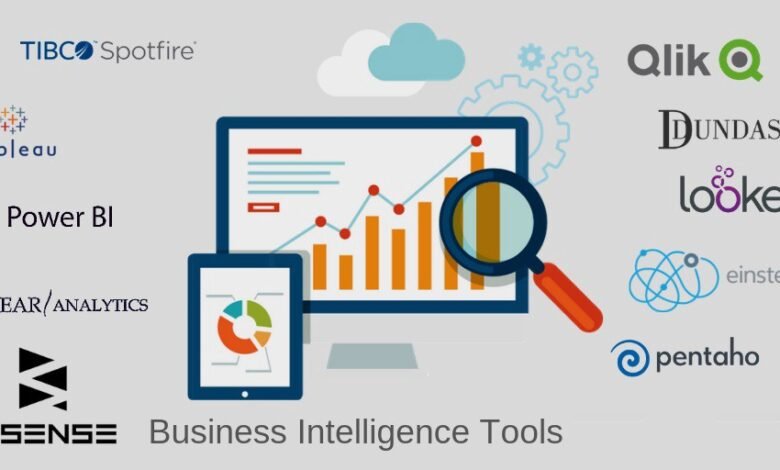Which Features Are Included in the Best BI Tools

Which Features Are Included in the Best BI Tools? It’s challenging to sort through all the data on your own to decide which business intelligence (BI) solution is ideal for your corporation. You can’t truly rely on evaluations to be truthful and accurate because many of them are sponsored by the business intelligence tool provider. Additionally, there are numerous possibilities, making it difficult to compare them all.
When making this choice, however, you don’t have to rely solely on your own efforts; research firm Gartner releases an annual report (the Magic Quadrant Business Intelligence report) that features a variety of providers in business intelligence and analytics. Their 2022 report has 42 pages of vendor and market trend research. Only three of the 20 vendors in the research were granted Gartner’s top grade of “Leaders,” out of a possible 20. One of them was the BI tool from Qlik; the other two were from Power BI and Tableau.
Because not everyone has the time to go through 42 pages of technical details, Gartner’s study includes a two-dimensional matrix that provides a quick comparison of all the suppliers. The graph’s selection criteria are as follows:
- Completeness of Vision – includes innovation, market understanding, and product strategy
- Ability to Execute – includes the customer experience, product capabilities, company viability, and pricing.
Only three suppliers met both requirements well enough to be deemed “Leaders”; the remaining merchants were classified as “Challengers,” “Visionaries,” and “Niche Players.” A BI tool may have more specialised skills and less overall utility when compared to the best business intelligence tools, but receiving a grade lower than “Leader” does not indicate that it is fundamentally deficient.
Which Features Are Included in the Best BI Tools

Key Aspects To Consider
It’s crucial to choose a business intelligence tool with the required functionality, but you shouldn’t base your decision just on that. For instance, data analysis skills are typically at the top of the list, but your business may wish to put more emphasis on mobile mobility or multi-cloud storage.
The overall cost of ownership could go much beyond the price of the BI product. It may also include setup fees, administrative fees, an increase in data volume, or additional technology. The cost of the BI tool alone might be affordable, but the overall cost might not.
Inspect the BI tool to ensure that it offers both passive and active data. Reports contain passive data, which is derived from past data. Active data is created in real time and allows your business to react instantly to important information.
If you want your data to come together into a logical whole, data integration is essential. The BI tool can better utilise data by converting, merging, and cataloguing raw data as it becomes available.
A BI tool should offer both passive and active data, so check this. You receive passive data in reports, which is derived from past data. Real-time active data generation helps your business to react quickly to important information.
If you want your data to make sense as a whole, integration of the data is essential. The BI tool may use data more efficiently by aggregating, categorising, and converting raw data as it becomes available.
Capabilities in top-rated business intelligence tools

The most important thing to know when choosing the best BI tool is what the best BI tools provide and how the alternative you’re evaluating compares. You don’t need to be familiar with every capacity being given. You should have high criteria for every BI tool you choose, regardless of whether you’re searching for the best of the best or a tool with a limited set of features.
Analysis
Even when the data sets are complex or huge, users can still obtain real-time data with the use of interactive dashboards. The dashboards foster greater interaction with data, present performance summaries, and simplify report generation.
Machine learning automation is used in augmented analytics to improve the quality and profiling of data. Users can receive alerts for outliers, anomalies, and other data changes as soon as they occur, allowing them to immediately identify correlations, variances, relationships, and trends.
Pie charts and bar graphs are only the beginning of data visualisation, which also includes more complex data sets that require more specialised renderings. This feature should be smart enough to depict many types of data sets since it is intended to aid users in quickly understanding data sets.
The BI tool is accessible to consumers wherever they are thanks to full mobile capabilities. Everyone may stay informed even if they are not close to their primary desktop computers thanks to dashboards that are mobile-optimized.
Read More:The Top Space Heaters for the winter Season [2023]
Ease of Use
- No matter whether element of the business intelligence product a user is using, embedded analytics provides data to them with real-time reports, data visualisations, interactive dashboards, and analytical capabilities. This promotes accessibility and streamlines workflows.
- A user-friendly design and more conversational language improve data literacy. As a result, consumers may begin interacting with the data right away rather than needing to first learn how to utilise the BI tool.
- Whether a user is creating a report or undertaking a deep-dive into massive data sets, a single interface guarantees consistency in the user experience.
Managing Data
- If you want a BI solution to grow with your firm, scalability is essential. Limitations like user limitations might not be a concern at first, but if your BI tool isn’t fully scalable, they could become a major issue later.
- Users can instantly access existing data sources without the need for extra software or new code thanks to data integration.
- Data integrity is maintained while providing access to stakeholders throughout the entire company using governed self-service. It’s simpler to manage the risk of data corruption because permissions may be customised for each user.
- Your business won’t be forced to choose a data storage solution that may not be viable for the long run if you have a flexible cloud approach.
- For the next five years, a business intelligence tool might provide a respectable data storage solution, but what about the following twenty years? You will have all the flexibility you could possible need with a multi-cloud storage solution.
The takeaway
Two questions should be asked while you look for the best business intelligence platform. Which choice, first, is actually the best? This shouldn’t be too difficult as long as you can select a small number of the strongest candidates. Second, how specifically will the greatest BI tools benefit your company? Following the completion of these two queries, you need to be able to locate the BI tool that your company requires.











